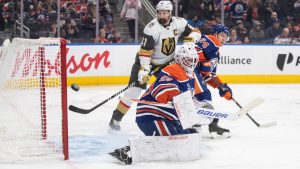Platoon goaltending is like baseball’s version of “bullpen by committee.”
Every baseball manager who has told the media with a straight face that he’s OK with rotating the closer’s job through a few bullpen arms, is privately pleading with his GM to find one guy who can finish a game with authority.
And every hockey coach who declares that he’s comfortable with using two goalies on a regular basis come playoff time knows that if he had a true No. 1, he’d be riding him every day come May and June.
Since the ‘04-05 lockout, there have been a few examples of teams who made some noise with two guys minding the nets. Most times, it’s been one guy taking the net from the original starter and stealing the job outright, the J.S. Giguere did from Ilya Bryzgalov in 2007 for Anaheim.
Matt Murray stole the nets from Marc-Andre Fleury in the Conference Final in 2017 and won the Penguins a Cup. And, of course, there was the 2010 Flyers, where Brian Boucher and Michael Leighton shared the net, as the Flyers made it to a Stanley Cup Final against Chicago.
In Edmonton, the problem is the same as it was in Philly. They simply do not have one guy.
But perhaps the bigger issue is that both goalies they do have are playing so well of late, it’s darned near impossible to figure out who to give the job to.
Did you see Mikko Koskinen duel it out with Darcy Kuemper in a 2-1 shootout loss to Colorado on Saturday? We don’t care what Koskinen’s reputation is, or how much he makes — that level of goaltending wins playoff games.
Then there’s Mike Smith, who is sporting a .918 save percentage over his last seven starts (6-0-1). This is the first time he’s been right all season, and Smith finally looks like the guy who got some Vezina votes last season — even at age 40.
Edmonton’s goaltending has been above average since Woodcroft, who has received a .912 saves percentage, arrived. Over a full season, a .912 team saves percentage at all strengths is top 10 in the NHL.
“Ever since I’ve been here both goaltenders are proving they want the net,” said Oilers coach Jay Woodcroft. “Both are competitors, veterans who know how to win in this league, guys who bring different attributes to the table…
“Both are driven, both are leaders, even though they have totally different personalities,” he said. “Having both playing at the level they’re at now is a good luxury.”
If you go as far back as Jan. 22 —Game 37 of the season for Edmonton – both goalies have save percentages of better than .900 (.913 to .904 for Koskinen), and goals-against averages of less than 3.00 (2.76 to 2.98 for Koskinen).
If you narrow your scope to the past month, the scenario flips. Smith leads in both saves percentage, .923 to .905, and in GAA — 2.50 to 3.05. That nine-goal night in Calgary — where Koskinen allowed five goals on 12 shots — skews things a bit in the smaller window.
Edmonton embarks on a quick two-game road trip through Minnesota and Nashville this week, then gets Vegas for a Saturday afternoon engagement.
But who will play in Game 1 of the playoffs come May? Well…
If both goalies are stopping pucks at an equal rate, there is absolutely no question that Smith is a more valuable netminder because of his superior puck-handling ability. Sure, every 10 games or so a Smith gaffe costs your team a goal. But count the number of times every period that he collects a dump-in, puts it right on the tape of a defenceman, and a smooth zone exit follows.
The risk-reward in Smith’s game is not even close. His puck handling is a huge advantage, and helps keep the D-corps healthy as well. And late in a game, a trailing team is forced to try and carry the puck over the blue line, which increases turnovers on their zone entries.
We’ve always said, stopping the puck is far more important than playing the puck. But if Smith is healthy and stopping it like has recently, he plays ahead of Koskinen because of the puck handling element. It’s a game-changer.
Add to that the intangibles: Smith is a fiery, talkative, imposing figure on the ice, and a take-charge leader off the ice. On a team that has to learn how to expect to win in the playoffs, Smith is a guy you want in the middle of the fight — not on the periphery, wearing a ball cap.
In the big picture this season, Koskinen has been the better goalie. Full stop.
He’s played nearly twice as many minutes (2,384 to 1,280), started twice as many games (39 to 22) and carried the Oilers through a season that saw Smith — who was supposed to make 50 starts — get into just 23 games thus far.
Somehow, in his young 30’s, Koskinen’s game has stabilized in the final year of that crazy three-year deal that punctuated Peter Chiarelli’s exit as Oilers GM. His glove hand, once an easy target for NHL shooters, has improved at age 33. He catches more pucks for stoppages than he used to, and doesn’t get beat there as often. Meanwhile, his lateral movement is better today than it was two years ago – if you can believe that.
The big Finn has even been better under increased workloads this season, an Achilles heel in the past. However, Koskinen is still a below-average puck-handler, which stands in stark contrast to Smith. When it comes to breaking out the puck, the Oilers are a different team with Koskinen in net, compared to Smith.
In the end, you’d have to say that Koskinen has been a better goalie this season, even if the two are virtually tied of late. But in a what-have-you-done-for-me-lately world, Koskinen may have to settle for coming off the bench come playoff time.
If they’re stopping pucks at the same rate, I start Smith all day long. And, as stated above, we’d much rather have one guy than a two-man system.
But with Smith’s injury history, it’s comforting knowing that Koskinen is playing the best hockey of his NHL career.




